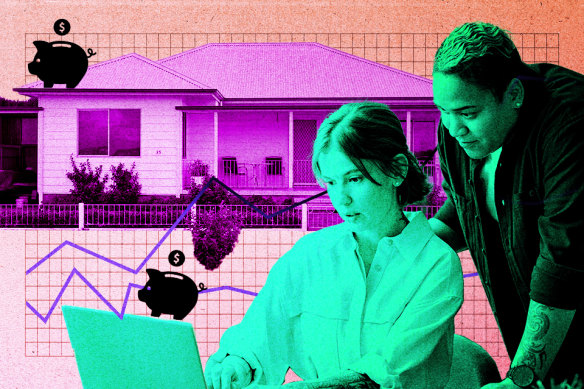Struggling with your mortgage payments? Here’s what you can do

Save articles for later
Add articles to your saved list and come back to them any time.
Real Money, a free weekly newsletter giving expert tips on how to save, invest and make the most of your money, is sent every Sunday. You’re reading an excerpt − sign up to get the whole newsletter in your inbox.
As I’m sure most of you know, the RBA decided to hike rates yet again this week, raising the official cash rate by 0.25 of a percentage point to an 11-year high of 4.1 per cent. This will add almost $100 to monthly repayments on the average $600,000 mortgage, and governor Philip Lowe has warned of more rate rises to follow as the central bank tries to battle inflation. He also said struggling Australians should just spend less and work more if they’re feeling the pinch. Thanks Phil, hadn’t thought of that one!
Thanks to the “lag” in how economic policy flows through, the effect of our 12 interest rate increases has only recently started to be fully felt by households.Credit: Aresna Villanueva
While rate rises have become a regular fixture over the past year, the “lag” in how economic policy flows through means the effect of our 12 interest rate increases has only recently started to be fully felt by households. But now it has become clear that more and more of us are under pressure from our rising mortgage repayments, and it’s only likely to get worse.
What’s the problem?
This week, my inbox was peppered with various data points revealing the level of mortgage stress Australians are under. Roy Morgan data gathered before the most recent rate rise shows 27.8 per cent of mortgage holders are now considered “at risk” of mortgage stress, the highest level since the Global Financial Crisis. Research from comparison website Finder indicates 40 per cent of homeowners struggled to pay their mortgage in May. According to Finder, the average mortgaged household would now be considered to be suffering from mortgage stress, defined as using more than 30 per cent of their income to cover mortgage repayments. Westpac boss Peter King has also said calls to the bank’s hardship line have increased recently, though he notes customers are yet to push the “help button”.
What you can do about it
The “button” King is referring to here is hardship arrangements, where mortgage holders enter into a temporary agreement with the bank to set up a payment plan or alter loan repayments. However, that’s typically a last resort move – here are some things you can try first:
- Pick up the phone: If you haven’t already done so, have a chat with your lender about your current loan, as there’s a good chance you might not be getting the best available rate. Alexandra Kelly, director of casework at the Financial Rights Legal Centre, says “Don’t be afraid to question if they say you’re on the best available. Asking to speak to the lender’s retention team can also sometimes unlock better offers. Failing that, shop around and switch if there are better deals on the market.”
- Be prepared: One of the reasons it has taken some time for the full brunt of interest rate rises to hit is because many homeowners took out fixed-rate loans during the pandemic. And while those still on low fixed-rate loans may be sitting pretty currently, it’s important to be prepared for when that term eventually expires, says financial adviser Jess Brady. “Figure out what your repayments would be once the fixed rate period is up and start putting that amount away every month. This will ensure you will be able to handle the increases when they arrive and means you have a buffer of cash if needed.” Some fixed-rate loans may also allow additional payments, which could be a wise move if you have the means to tip in some extra before your term ends.
- Ask for help, but not necessarily on your mortgage: If you do find yourself in a situation where you need to negotiate new payment terms with your lenders, try to leave your main debts – such as your mortgage – until last. Kelly says it’s often possible to negotiate interest-free repayment arrangements on credit cards or long-term arrangements on energy bills. However, it’s important to note there’s no obligation to offer hardship provisions on some debts, such as strata fees.
- Talk to your bank, and don’t feel bad about it: Once you’ve exhausted your other options, you may need to call your lender and push the “help button”. People are often scared to do this, as there’s an inherent aversion to admitting to your lender you can’t make your repayments, but there’s no need to feel this way. Banks have full teams in place to help people in financial hardship, and they can help you come up with a workable repayment plan. Brady also notes doing this will not negatively affect your credit score. “Whilst this will extend the life of your loan (meaning over the long run you will pay more interest), it may give you precious time to get back on your feet or be able to sell an asset for fair market value (rather than panic selling for a low price),” she says.
There are a number of services available offering free financial counselling for anyone who may need to explore their options, including the National Debt Helpline (1800 007 007) and other local services. Additionally, if your lender is being uncooperative, you can submit a complaint to the Australian Financial Complaints Authority.
- Advice given in this article is general in nature and is not intended to influence readers’ decisions about investing or financial products. They should always seek their own professional advice that takes into account their own personal circumstances before making any financial decisions.
Most Viewed in Money
Source: Read Full Article

